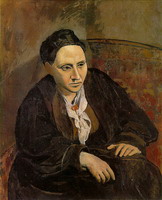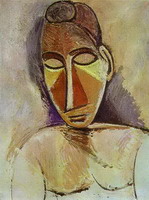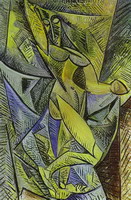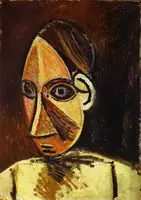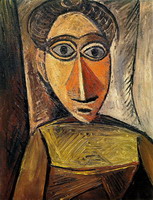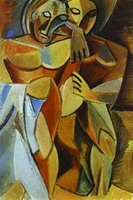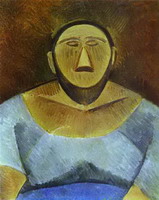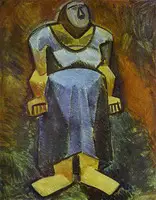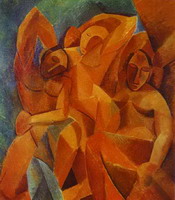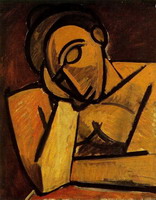 The first work by Picasso, which turned him towards a new figurativeness, was the "Portrait of Gertrude Stein", 1906. By repainting it 80 times, the artist was desperate to depict the writer in the classical style. The artist was ready for a new creative period and ceased to be interested in life models. This piece can be regarded as the first step towards shape deformation.
The first work by Picasso, which turned him towards a new figurativeness, was the "Portrait of Gertrude Stein", 1906. By repainting it 80 times, the artist was desperate to depict the writer in the classical style. The artist was ready for a new creative period and ceased to be interested in life models. This piece can be regarded as the first step towards shape deformation.
In 1907, Picasso first encountered the archaic African art at the Ethnographic Museum exhibition in Trocadero. The primitive idols, statues and masks, the generalized form of which freed itself from the flickering of parts, embodied the mighty forces of nature, from which primitive man did not distance himself. Picasso’s ideology invariably put art above all else, coinciding with the powerful message implicit in these images: instead of being a household decoration, art was magic for the ancient people; magic, which tamed the incomprehensible and hostile spirits who controlled the dangerous earthly life.
Picasso took the path which was dictated by the intuition of a savage. He monumentalized and simplified the shapes, making his characters look like wooden or stone idols. Characters’ faces started to resemble ritual masks. Rough shading on the picturesque planes, reproducing the notches on the African sculptures is another borrowing from the battery of the ancient masters. The fusion of characters with surroundings was the main thing that Picasso learned from the African “spirit charmers”, since the primitive man did not separate himself from nature. In Picasso’s paintings, background seems as tangible as the figures. Pieces from the African Period give the impression of clumsy bas-reliefs roughly carved out of natural materials.
The famous and scandal "The Young Ladies of Avignon (1907)" was appeared in 1907. The picture named by the poet A Salmon was the first step of masterpiece on the way to cubism and many experts in art mean it the starting dot of the modern art. The piece was repeatedly redrawn (it took the artist about a year to finish the painting), and the women were eventually turned into raw statuettes with savagely deformed faces of African gods, which is particularly noticeable in the two females on the right. The fondness of picturing the beauty of the female body inherent in artists of the previous eras was replaced by a radical distortion of the body shell architecture. The deformation of shapes and the schematic representation of faces was considered an act of misogyny and caused a sharp rejection in people who were the first viewers of that piece.
In the following works from the African Period Picasso experimented with the found method. His aim was to create an illusion of three-dimensional space populated by deformed beings at the two-dimensional plane of the canvas. The second half of 1907 was the birth of a string of distorted characters with more or less horrible African masks replacing their faces: Three Figures under a Tree, "Dance of the Veils", Dryad, Three Women, "Woman's Head", Bathing, "Self-Portrait", Head of a Man, and Farmer’s Wife.
Due to the merchant and philanthropist S.I. Shchukin, who had the best collection of the French art of the twentieth century in Europe, 51 Picasso’s works ended up in Russia in 1914, including "Friendship" and Dance of the Veils. Sometimes lacking the understanding of the new directions of Picasso’s avant-garde search, Shchukin wisely admitted: “…Perhaps, it is he who is right, not me…”
"African" Period
 The first work by Picasso, which turned him towards a new figurativeness, was the "Portrait of Gertrude Stein", 1906. By repainting it 80 times, the artist was desperate to depict the writer in the classical style. The artist was ready for a new creative period and ceased to be interested in life models. This piece can be regarded as the first step towards shape deformation.
The first work by Picasso, which turned him towards a new figurativeness, was the "Portrait of Gertrude Stein", 1906. By repainting it 80 times, the artist was desperate to depict the writer in the classical style. The artist was ready for a new creative period and ceased to be interested in life models. This piece can be regarded as the first step towards shape deformation.
In 1907, Picasso first encountered the archaic African art at the Ethnographic Museum exhibition in Trocadero. The primitive idols, statues and masks, the generalized form of which freed itself from the flickering of parts, embodied the mighty forces of nature, from which primitive man did not distance himself. Picasso’s ideology invariably put art above all else, coinciding with the powerful message implicit in these images: instead of being a household decoration, art was magic for the ancient people; magic, which tamed the incomprehensible and hostile spirits who controlled the dangerous earthly life.
Picasso took the path which was dictated by the intuition of a savage. He monumentalized and simplified the shapes, making his characters look like wooden or stone idols. Characters’ faces started to resemble ritual masks. Rough shading on the picturesque planes, reproducing the notches on the African sculptures is another borrowing from the battery of the ancient masters. The fusion of characters with surroundings was the main thing that Picasso learned from the African “spirit charmers”, since the primitive man did not separate himself from nature. In Picasso’s paintings, background seems as tangible as the figures. Pieces from the African Period give the impression of clumsy bas-reliefs roughly carved out of natural materials.
The famous and scandal "The Young Ladies of Avignon (1907)" was appeared in 1907. The picture named by the poet A Salmon was the first step of masterpiece on the way to cubism and many experts in art mean it the starting dot of the modern art. The piece was repeatedly redrawn (it took the artist about a year to finish the painting), and the women were eventually turned into raw statuettes with savagely deformed faces of African gods, which is particularly noticeable in the two females on the right. The fondness of picturing the beauty of the female body inherent in artists of the previous eras was replaced by a radical distortion of the body shell architecture. The deformation of shapes and the schematic representation of faces was considered an act of misogyny and caused a sharp rejection in people who were the first viewers of that piece.
In the following works from the African Period Picasso experimented with the found method. His aim was to create an illusion of three-dimensional space populated by deformed beings at the two-dimensional plane of the canvas. The second half of 1907 was the birth of a string of distorted characters with more or less horrible African masks replacing their faces: Three Figures under a Tree, "Dance of the Veils", Dryad, Three Women, "Woman's Head", Bathing, "Self-Portrait", Head of a Man, and Farmer’s Wife.
Due to the merchant and philanthropist S.I. Shchukin, who had the best collection of the French art of the twentieth century in Europe, 51 Picasso’s works ended up in Russia in 1914, including "Friendship" and Dance of the Veils. Sometimes lacking the understanding of the new directions of Picasso’s avant-garde search, Shchukin wisely admitted: “…Perhaps, it is he who is right, not me…”


